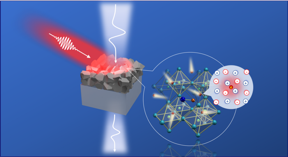Home > Press > Photoinduced large polaron transport and dynamics in organic-inorganic hybrid lead halide perovskite with terahertz probes
 |
| The photoexcited charge carrier is dressed by the local lattice distortion, which is revealed by ultrafast conductivity measurements using terahertz transient.
CREDIT by Zuanming Jin, Yan Peng, Yuqing Fang, Zhijiang Ye, Zhiyuan Fan, Zhilin Liu, Xichang Bao, Heng Gao, Wei Ren, Jing Wu, Guohong Ma, Qianli Chen, Chao Zhang, Alexey V. Balakin, Alexander P. Shkurinov, Yiming Zhu, Songlin Zhuang |
Abstract:
Organic-inorganic hybrid metal halide perovskites (MHPs) have attracted tremendous attention for optoelectronic applications. For example, cost-effective solar cells, solid-state lighting, memristors, and ultrafast spin switches in spintronics have recently been designed using MHPs. Despite the promise of the material, many questions remain regarding the nature and mobility of charge carriers in MHPs, which require further understanding.
Photoinduced large polaron transport and dynamics in organic-inorganic hybrid lead halide perovskite with terahertz probes
Changchun, China | Posted on July 8th, 2022
Researchers from the University of shanghai for science and technology, in collaboration with Qingdao institute of bioenergy and bioprocess technology, Shanghai University, Shanghai institute of technical physics, Shanghai Jiao Tong University, and Lomonosov Moscow State University, now report photoinduced large polaron transport and dynamics in organic-inorganic hybrid lead halide perovskite with terahertz probes.
The researchers experimentally identify the photocarriers-optical phonon coupling in CH3NH3PbI3 (MAPbI3) polycrystalline grains, by using optical-pump and terahertz-electromagnetic probe spectroscopy. The photoinduced charge carrier, together with the surrounding lattice distortion over several lattice constants, forms a quasi-particle – a polaron. Using the Drude-Smith-Lorentz model along with the Frӧhlich-type electron-phonon coupling, the researchers determine the effective mass and scattering parameters of photogenerated polaronic carriers. According to the polaron mass enhancement, the polycrystalline nature of the material, and the presence of defects, the large polaron mobility is calculated on the order of ~80 cm2V−1s−1.
Furthermore, the researchers reveal that the formation of large polarons in MAPbI3 protects the charge carriers from scattering with polycrystalline grain boundaries or defects and explains the long lifetime of photoconductivity. The findings provide insights into the polaronic nature of charge carriers in MAPbI3 materials, which is relevant for both fundamental researches and device applications. The results are published in the journal Light: Science & Applications.
####
For more information, please click here
Contacts:
Media Contact
Yaobiao Li
Light Publishing Center, Changchun Institute of Optics, Fine Mechanics And Physics, CAS
Office: 86-431-861-76851
Expert Contact
Yan Peng
University of Shanghai for Science and Technology, China
Copyright © Light Publishing Center, Changchun Institute of Optics, Fine Mechanics And Physics, CAS
If you have a comment, please Contact us.
Issuers of news releases, not 7th Wave, Inc. or Nanotechnology Now, are solely responsible for the accuracy of the content.
News and information
![]()
Electrically driven single microwire-based single-mode microlaser July 8th, 2022
![]()
Deep-ultraviolet nonlinear optical crystals: Concept development and materials discovery July 8th, 2022
![]()
Optical demonstration of quantum fault-tolerant threshold July 8th, 2022
Perovskites
![]()
Workhorse of photovoltaics combined with perovskite in tandem for the first time February 25th, 2022
![]()
Photon recycling The key to high-efficiency perovskite solar cells January 14th, 2022
Display technology/LEDs/SS Lighting/OLEDs
![]()
A solution to perovskite solar cell scalability problems April 22nd, 2022
![]()
Graphene crystals grow better under copper cover April 1st, 2022
Memristors
![]()
Artificial neurons go quantum with photonic circuits: Quantum memristor as missing link between artificial intelligence and quantum computing March 25th, 2022
![]()
New brain-like computing device simulates human learning: Researchers conditioned device to learn by association, like Pavlov’s dog April 30th, 2021
Govt.-Legislation/Regulation/Funding/Policy
![]()
Solving the solar energy storage problem with rechargeable batteries that can convert and store energy at once June 24th, 2022
![]()
Boron nitride nanotube fibers get real: Rice lab creates first heat-tolerant, stable fibers from wet-spinning process June 24th, 2022
Possible Futures
![]()
Luisier wins SNSF Advanced Grant to develop simulation tools for nanoscale devices July 8th, 2022
Spintronics
![]()
Magnet-free chiral nanowires for spintronic devices March 18th, 2022
![]()
NGI advances graphene spintronics as 1D contacts improve mobility in nano-scale devices February 11th, 2022
![]()
Terahertz light-driven spin-lattice control: A new potential path to faster and more efficient data storage January 7th, 2022
Chip Technology
![]()
Electrically driven single microwire-based single-mode microlaser July 8th, 2022
![]()
Optical demonstration of quantum fault-tolerant threshold July 8th, 2022
![]()
Photonic synapses with low power consumption and high sensitivity are expected to integrate sensing-memory-preprocessing capabilities July 1st, 2022
Optical computing/Photonic computing
![]()
Deep-ultraviolet nonlinear optical crystals: Concept development and materials discovery July 8th, 2022
![]()
Photon-controlled diode: an optoelectronic device with a new signal processing behavior July 1st, 2022
![]()
Efficiently processing high-quality periodic nanostructures with ultrafast laser July 1st, 2022
![]()
Photonic synapses with low power consumption and high sensitivity are expected to integrate sensing-memory-preprocessing capabilities July 1st, 2022
Discoveries
Announcements
![]()
Luisier wins SNSF Advanced Grant to develop simulation tools for nanoscale devices July 8th, 2022
Interviews/Book Reviews/Essays/Reports/Podcasts/Journals/White papers/Posters
![]()
Optical demonstration of quantum fault-tolerant threshold July 8th, 2022
Grants/Sponsored Research/Awards/Scholarships/Gifts/Contests/Honors/Records
![]()
Luisier wins SNSF Advanced Grant to develop simulation tools for nanoscale devices July 8th, 2022
![]()
Boron nitride nanotube fibers get real: Rice lab creates first heat-tolerant, stable fibers from wet-spinning process June 24th, 2022
Solar/Photovoltaic
![]()
Key in increasing efficiency of next-generation solar cell, found in light absorption capacity! July 1st, 2022
![]()
Solving the solar energy storage problem with rechargeable batteries that can convert and store energy at once June 24th, 2022
![]()
USTC found a pathway to high-quality ZnSe quantum wires April 8th, 2022
![]()
Graphene crystals grow better under copper cover April 1st, 2022










